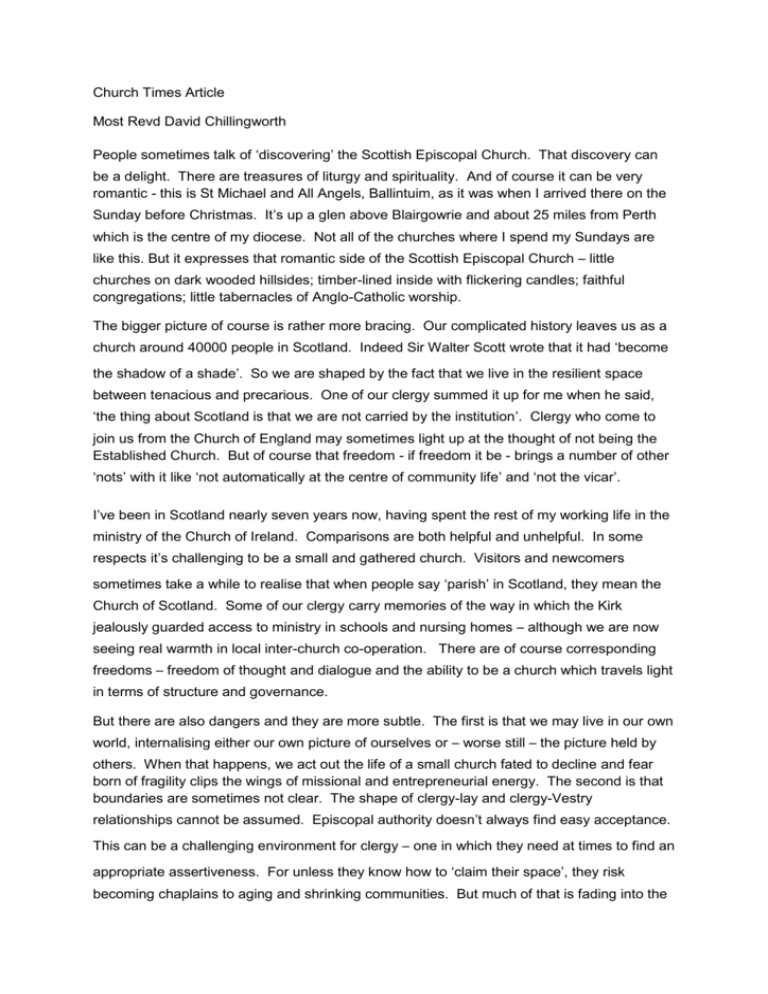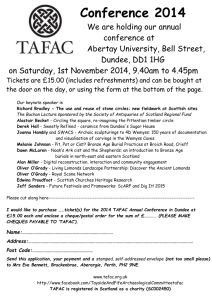Church-Times-Article
advertisement

Church Times Article Most Revd David Chillingworth People sometimes talk of ‘discovering’ the Scottish Episcopal Church. That discovery can be a delight. There are treasures of liturgy and spirituality. And of course it can be very romantic - this is St Michael and All Angels, Ballintuim, as it was when I arrived there on the Sunday before Christmas. It’s up a glen above Blairgowrie and about 25 miles from Perth which is the centre of my diocese. Not all of the churches where I spend my Sundays are like this. But it expresses that romantic side of the Scottish Episcopal Church – little churches on dark wooded hillsides; timber-lined inside with flickering candles; faithful congregations; little tabernacles of Anglo-Catholic worship. The bigger picture of course is rather more bracing. Our complicated history leaves us as a church around 40000 people in Scotland. Indeed Sir Walter Scott wrote that it had ‘become the shadow of a shade’. So we are shaped by the fact that we live in the resilient space between tenacious and precarious. One of our clergy summed it up for me when he said, ‘the thing about Scotland is that we are not carried by the institution’. Clergy who come to join us from the Church of England may sometimes light up at the thought of not being the Established Church. But of course that freedom - if freedom it be - brings a number of other ‘nots’ with it like ‘not automatically at the centre of community life’ and ‘not the vicar’. I’ve been in Scotland nearly seven years now, having spent the rest of my working life in the ministry of the Church of Ireland. Comparisons are both helpful and unhelpful. In some respects it’s challenging to be a small and gathered church. Visitors and newcomers sometimes take a while to realise that when people say ‘parish’ in Scotland, they mean the Church of Scotland. Some of our clergy carry memories of the way in which the Kirk jealously guarded access to ministry in schools and nursing homes – although we are now seeing real warmth in local inter-church co-operation. There are of course corresponding freedoms – freedom of thought and dialogue and the ability to be a church which travels light in terms of structure and governance. But there are also dangers and they are more subtle. The first is that we may live in our own world, internalising either our own picture of ourselves or – worse still – the picture held by others. When that happens, we act out the life of a small church fated to decline and fear born of fragility clips the wings of missional and entrepreneurial energy. The second is that boundaries are sometimes not clear. The shape of clergy-lay and clergy-Vestry relationships cannot be assumed. Episcopal authority doesn’t always find easy acceptance. This can be a challenging environment for clergy – one in which they need at times to find an appropriate assertiveness. For unless they know how to ‘claim their space’, they risk becoming chaplains to aging and shrinking communities. But much of that is fading into the past and I think we are showing a growing confidence in our future. In all of our dioceses, various initiatives and mission-shaped developments are visible. The current generation of bishops see themselves as leaders of mission in their dioceses. Many of our cathedrals have become centres of excellence in liturgy and music and gather significant congregations. We have laity of extraordinary confidence, quality and passion for mission and ministry. As a small church, we can listen to the spirit and accept the challenge to substantially reshape ourselves – our Whole Church Mission and Ministry Policy aspires to do nothing less than that. The Policy recognises, for example, that there has been a significant shift in leadership and missional energy towards the dioceses. It seeks to define how we can more confidently take our place as a church in the mainstream of Scottish life. In spite of our long history in Scotland, we have not always been that. As our confidence grows, we are beginning to take seriously the possibility of significant ecumenical partnerships in areas like the training of the next generation of clergy. But of course the biggest opportunities are beginning to arise from our context. Whereas Ireland may have seemed to be as religious as Poland, Scotland looks as secular as France. It’s not an easy place for any faith groups. But I believe that it is actually a more difficult place for more institutionally-strong and conservatively-shaped churches than it is for us. Part of our media strategy says that ‘we are a church that talks about things’. That stance is surely a help in presenting ourselves to a society which is strongly averse to dogmatic presentations of faith but paradoxically open to thoughtful exploration of faith and its issues. We are becoming more confident about our engagement with the Scottish government and civic society and the presence of the devolved government at Holyrood makes that government accessible. We also have a watchful eye on the growing debate about Scottish Independence. My past in Ireland teaches me that churches should be agnostic about flags and jurisdiction while being passionate about justice and values. We are sometimes still known in Scotland as the ‘English Kirk’. Nobody knows whether or not Scottish independence will become a reality. But whatever happens, we can see that Scotland is becoming more conscious of its national identity. We need to reflect that and we are quietly becoming more confident about our Scottishness – our long history in Scotland, our part in the Scottish Reformation and our confidence about our future as an authentic expression of Anglicanism in Scotland.







